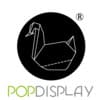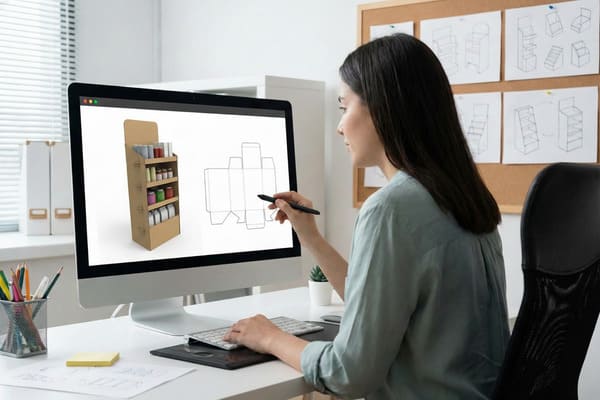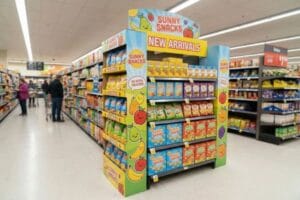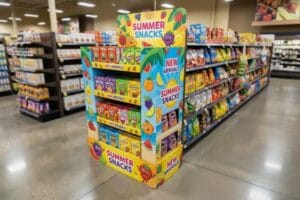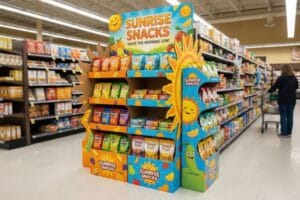Finding the right display can be frustrating when standard options fail to showcase your product effectively. You have a great product, but without a unique presentation, it risks blending into the background of a busy retail environment.
To customize a cardboard display, you must first define the structure based on product weight and retail footprint. Then, create a dieline for artwork placement. Finally, select digital or offset printing options and finish with coatings like lamination to ensure durability and brand consistency.
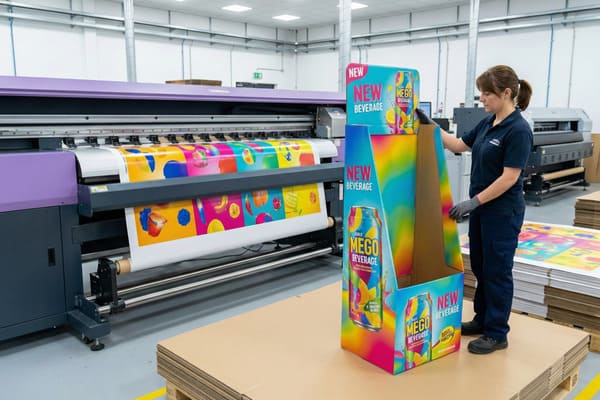
Let’s look at the specific steps and technical details required to get your display from a concept to the store shelf successfully.
How do you make a cardboard display stand?
A wobbly display can ruin your brand image instantly and annoy retailers. You need a structure that lasts through shipping and holds up under the weight of your products.
Making a cardboard display stand involves three key phases: structural engineering, printing, and cutting. It starts with CAD design to ensure load-bearing capacity. Next, the design is printed onto liner paper, laminated onto corrugated board, and finally die-cut and glued for easy assembly at the retail location.
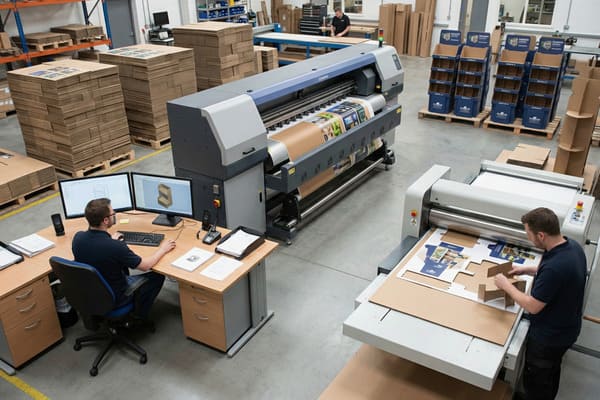
The Structural Anatomy of a Durable Display
Creating a cardboard display is not just about folding paper; it is a process of structural engineering that balances aesthetics with physics. When we design for heavy items, such as hunting gear or crossbows, we cannot rely on standard paper grades. The process begins with selecting the right flute profile. The "flute" is the wavy layer between the liner boards, and it dictates the stacking strength. For heavy-duty floor displays, we typically use a BC-flute1, which is a double-wall structure combining the fine surface of B-flute for printing and the rugged thickness of C-flute for strength.
Another critical technical aspect is the Edge Crush Test (ECT)2. This measures the stacking strength of the corrugated board. For a standard floor display, a 32 ECT rating might suffice, but for heavier merchandise, we must upgrade to 44 ECT or even 48 ECT board to prevent the unit from buckling over time. Retailers like Costco and Walmart have strict compliance manuals regarding these specifications. If a display collapses in an aisle, it is a liability issue. Therefore, the "grain direction" of the cardboard must be aligned vertically to maximize load-bearing capacity. During the manufacturing process, we also have to consider the environment. If the display is going to a humid region, standard glue might fail, so we must use moisture-resistant adhesives and coatings.
| Feature | B-Flute | C-Flute | BC-Flute (Double Wall) |
|---|---|---|---|
| Thickness | Approx. 3mm | Approx. 4mm | Approx. 7mm |
| Print Surface | Smooth, excellent for direct print | Average smoothness | Good smoothness (due to B outer) |
| Crush Resistance3 | Moderate | Good | Excellent |
| Best Application | Counter displays, small boxes | Standard shipping boxes | Heavy floor displays, Pallet skirts |
| Load Capacity4 | Light to Medium | Medium | Heavy |
I know that a collapsing display is a nightmare for your brand reputation and sales relationships. That is why at PopDisplay, my team runs rigorous load-bearing tests on every prototype before we cut a single piece for mass production, ensuring your products stay secure and upright.
What are custom display boxes?
Generic brown boxes disappear on the shelf and fail to attract customer attention. If your packaging does not actively sell the product, you are losing money every single day.
Custom display boxes are packaging solutions designed to hold products while simultaneously marketing them. They serve as both shipping containers and retail counter units (PDQs). These boxes feature high-quality graphics, custom inserts to secure items, and are engineered to increase product visibility in high-traffic retail areas.
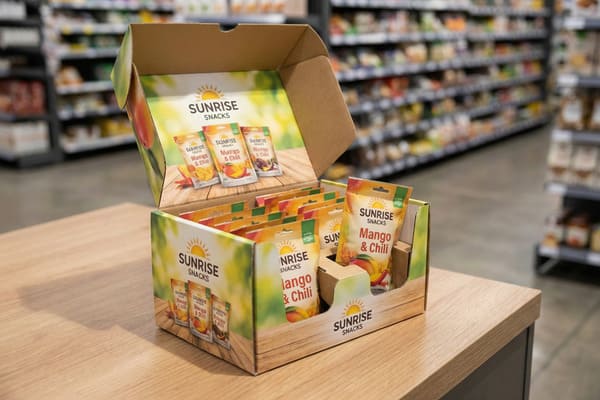
Strategic Retail Impact of PDQ Displays
Custom display boxes, often referred to in the industry as PDQs (Pretty Darn Quick)5 or Shelf Ready Packaging (SRP)6, are vital for the "last ten feet" of the sales cycle. The concept here is efficiency meets marketing. For a retailer, the box must be easy to open and place on the shelf without using a knife, which could damage the product. This is usually achieved through perforation lines or tear-away hoods. From a marketing perspective, the front lip of the box is prime real estate. It must be high enough to hold the product securely but low enough to reveal the branding on the primary packaging.
We also have to consider the "facing" of the product. If you are selling small accessories, a custom display box often utilizes internal dividers or tiered steps. This ensures that even as the front products are sold, the products behind them remain visible and upright, rather than falling over in a messy pile. The material used for these boxes is usually Clay Coated News Back (CCNB) laminated onto corrugated board. CCNB provides a white, glossy surface that allows for high-resolution printing, making the colors pop under harsh fluorescent store lighting. The structural design must also account for shipping stress; the display box acts as the shipper, so it must pass drop tests to ensure the product inside does not arrive damaged.
| Characteristic | Standard Shipping Carton7 | Custom Display Box (PDQ)8 |
|---|---|---|
| Primary Function | Protection during transport | Protection + Marketing |
| Visibility | None (Brown Box) | High (Custom Graphics) |
| Retail Setup | Requires unpacking/stocking | Shelf-ready immediately |
| Cost | Low | Medium |
| Brand Impact | Negligible | High |
I understand that you need to grab attention quickly in a busy store environment to drive impulse buys. We offer free structural design updates to make sure your display boxes are not only strong enough for shipping but also beautiful enough to drive sales immediately upon opening.
Can you print onto cardboard?
Faded colors and blurry text make products look cheap and unprofessional. You worry that cardboard cannot handle the high-resolution graphics and vibrant colors your brand requires.
Yes, you can print onto cardboard using flexographic, lithographic, or digital methods. Lithographic lamination offers the highest quality, allowing for photo-realistic images. Digital printing is ideal for short runs and rapid prototyping, while flexography is best for simple logos and high-volume shipping cartons.
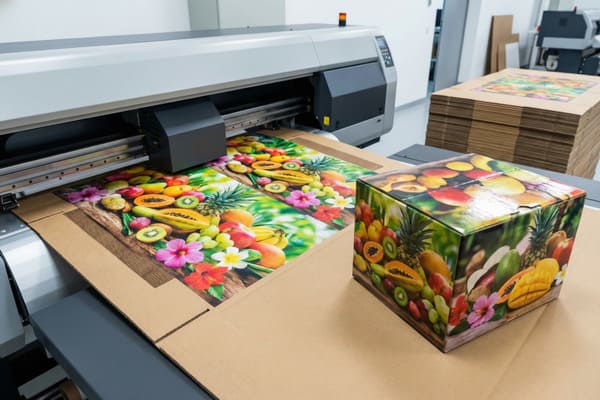
Achieving Color Consistency and High Resolution
The ability to print on cardboard has advanced significantly, but choosing the wrong method can lead to disaster. For high-end retail displays, direct printing on the corrugated board often results in a "washboard" effect, where the flute lines are visible through the ink. To solve this, we use Lithographic Lamination (Litho-lam)9. In this process, we print your artwork onto a high-quality sheet of paper first, usually using a 4-color (CMYK) or 6-color offset press. This allows for crisp, photo-realistic images at 300 DPI or higher. This printed sheet is then glued (laminated) onto the corrugated cardboard.
Color consistency is another major technical challenge. Colors on a computer screen (RGB) look different than printed ink (CMYK). Furthermore, the same ink formula looks different on recycled brown kraft paper versus white coated paper. To manage this, we use the Pantone Matching System (PMS)10. By specifying a Pantone code, we can ensure that your brand’s specific red or blue is identical across every production run. We also apply finishes to the print. A UV varnish or aqueous coating seals the ink, preventing it from rubbing off during transit and giving the display a premium gloss or matte finish. Without this coating, the display is susceptible to scratching and moisture damage.
| Method | Quality | Setup Cost | Ideal Quantity | Turnaround |
|---|---|---|---|---|
| Flexographic11 | Low/Medium | Medium | High Volume | Fast |
| Digital12 | High | Low | Low/Medium | Very Fast |
| Litho-Lamination | Highest (Photo) | High | Medium/High | Medium |
I know how frustrating it is when the final product looks different from the design file you approved. We use advanced color management systems to match your specific Pantone colors, ensuring your brand looks exactly the way you envisioned it on every single unit.
What is the HS code for cardboard display?
Importing goods can be a headache with the wrong paperwork and codes. Using the incorrect code leads to customs delays, unexpected inspections, and heavy fines.
The most common HS code (Harmonized System code) for cardboard displays is 4819.10 for corrugated paper and paperboard boxes. However, floor displays might fall under 4819.20 depending on specific customs interpretations. Always verify with your freight forwarder to ensure the correct classification for your destination country.
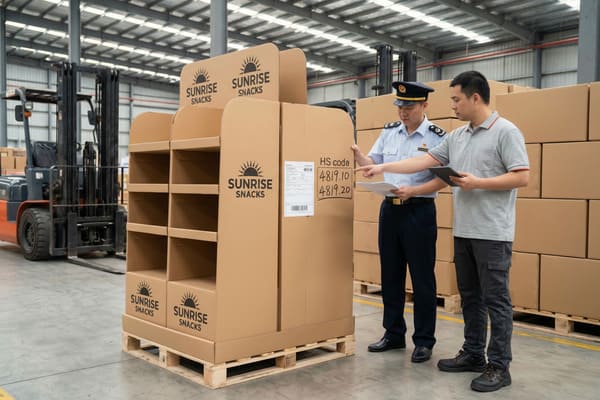
Navigating International Logistics and Tariffs
Understanding HS codes13 is essential for calculating your "landed cost14"—the total price of the product once it arrives at your door. The Harmonized System (HS) is a standardized numerical method of classifying traded products. For cardboard displays made in China and imported to the US, the classification determines the duty rate. Generally, Code 4819.10 covers "Cartons, boxes and cases, of corrugated paper or paperboard." This is the standard for most displays. However, if the display is complex or contains other materials (like plastic hooks or metal bars), customs might try to classify it differently, potentially attracting higher tariffs.
This is particularly relevant given recent trade tensions and tariff updates. A small error in classification can trigger a rigorous customs exam, delaying your shipment by weeks and causing you to miss your product launch date. Beyond the code, the way the product is packed affects shipping costs. We often ship displays "knocked down flat" (KDF) to maximize container space. A 40-foot container can hold thousands of flat displays but only a few hundred assembled ones. Proper documentation, including a detailed packing list and commercial invoice that matches the HS code exactly, is the only way to ensure smooth clearance through ports like Long Beach or New York.
| HS Code | Description | Typical Use |
|---|---|---|
| 4819.10 | Cartons, boxes of corrugated paper15 | Standard Displays & Shippers |
| 4819.20 | Folding cartons, non-corrugated16 | Small folding boxes |
| 4823.90 | Other paper/paperboard articles | Complex/Mixed material displays |
I realize that dealing with customs, tariffs, and logistics paperwork can be overwhelming for a buyer. We assist our clients by providing accurate HS codes and detailed packing lists, helping you avoid delays so your products arrive in time for your critical launch dates.
Conclusion
Customizable cardboard displays are essential for standing out in competitive retail spaces. By understanding the structural design, printing options, and logistics involved, you can create effective marketing tools that drive sales.
Exploring BC-flute will reveal how its unique structure enhances the strength and print quality of cardboard displays. ↩
Understanding the Edge Crush Test (ECT) is crucial for ensuring the strength and durability of cardboard displays, especially for heavy items. ↩
Understanding crush resistance helps in selecting the right packaging for your products, ensuring safety during transport. ↩
Exploring load capacity variations aids in choosing the appropriate flute type for your packaging needs, optimizing performance. ↩
Explore this link to understand how PDQs enhance retail visibility and sales effectiveness. ↩
Learn about SRP’s advantages in retail, including efficiency and improved product presentation. ↩
Learn about the essential role of Standard Shipping Cartons in protecting products during transport. ↩
Explore how Custom Display Boxes enhance brand visibility and marketing effectiveness in retail settings. ↩
Explore this link to understand Litho-lam, a crucial process for achieving high-quality prints on cardboard. ↩
Learn about PMS to see how it guarantees your brand colors remain consistent across different materials. ↩
Explore the benefits of Flexographic printing to understand its applications and efficiency in high-volume production. ↩
Learn about Digital printing’s advantages over traditional methods for quick and high-quality results. ↩
Understanding HS codes is crucial for accurate tariff calculations and avoiding costly customs delays. ↩
Exploring landed cost helps businesses calculate total expenses, ensuring better pricing strategies and profit margins. ↩
Explore the advantages of corrugated paper cartons for packaging and shipping, enhancing product safety and sustainability. ↩
Learn about the diverse applications of non-corrugated folding cartons in retail and packaging, optimizing product presentation. ↩
